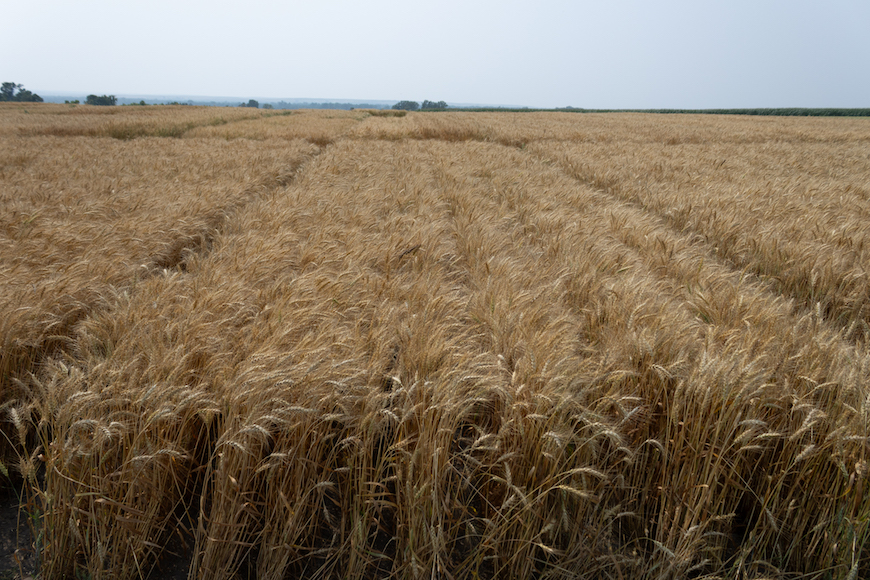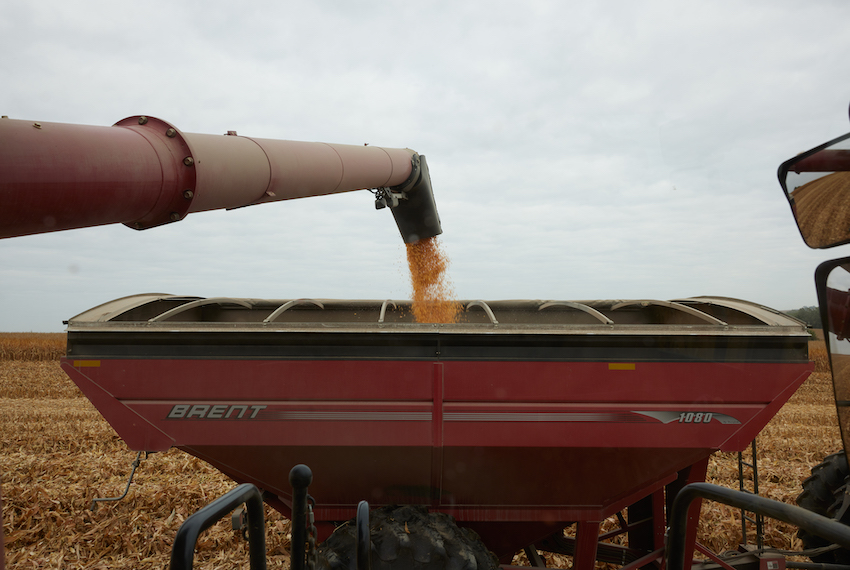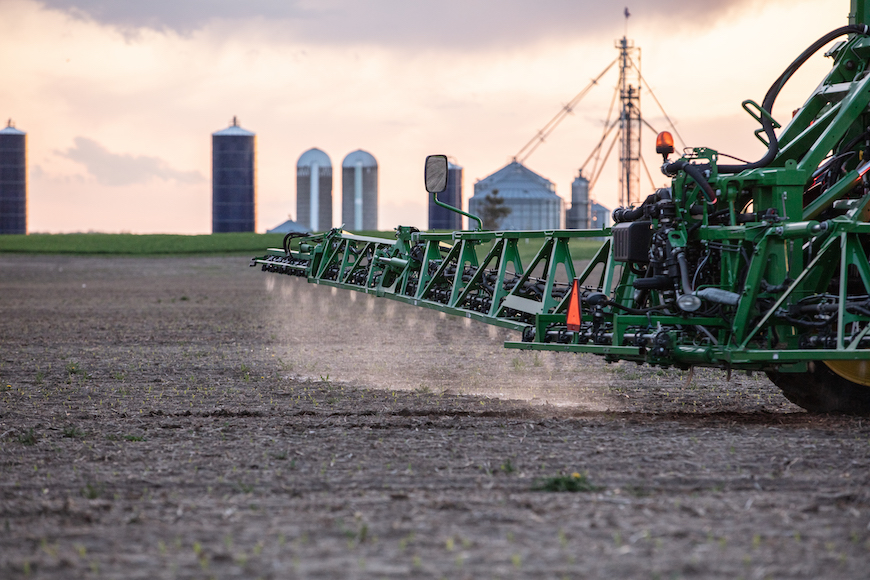Apr 21, 2025
4 Key Stages to Treat Your Wheat with Fungicides

When it comes to treating a wheat crop with fungicides, I’m often asked why we need to make multiple applications over the course of the growing season. Can’t we eliminate those time-consuming trips across the field and get the same results by making just one all-encompassing pass?
In short, the answer is no. Unfortunately, each fungicide application helps protect against diseases at a specific period of time in a wheat stand’s growth, and no single fungicide product provides season-long residual protection. Let’s take a look at these four applications and why they play such an important role in preserving your crop’s yield potential.
CROPLAN wheat can be treated with one of three different Warden® Cereals seed treatment options to help farmers protect against a number of diseases that thrive under cool and wet conditions, including Rhizoctonia, Phytophthora and Pythium damping off early in the year. These seed treatments are Warden Cereals HR, Warden Cereals II and Warden Cereals WRII.
In addition to helping prevent major crop and economic losses, these seed treatments can set the stage for optimal yield potential by helping to build a strong root system for optimal uptake of water and nutrients. You can provide your wheat stand with all the fertility in the world, but it won’t do any good if the crop can’t access it. Warden seed treatments help provide wheat plants with the foundation they need to succeed by promoting a strong root system. If you’re wondering which seed treatment is best for your acres, consult your local CROPLAN retailer.
A triazole like Topaz® fungicide can help protect against the aforementioned diseases, as can a dual-mode-of-action SDHI and strobilurin product like Everlon™ fungicide, which offers both preventive and curative activities, systemic movement and a residual to provide broader-spectrum, longer-lasting protection against disease.
The key to making a successful fungicide application at tillering is to begin spraying preventatively as soon as conditions are favorable for disease development. If you wait to spray until a disease has already manifested, irreversible loss of yield potential will occur. This applies to curative fungicides as well as preventative. Fungicides with curative properties won’t turn a yellow leaf back to green; they might keep younger pustules from developing, but they won’t correct the damage caused by older pustules.
To determine the best time to spray, consider current weather conditions, constantly scout your fields and keep a close eye on stripe rust websites that monitor the regional progress of windblown spores, such as the USDA’s Cereal Rust Report.1
Farmers have long known that a well-timed fungicide application might provide a good return on investment when conditions are favorable for disease development. But the problem has always been scouting to decide if an application is warranted and then spraying within a small window to achieve adequate protection – specifically when the flag leaf is 50 percent to fully emerged. Historically, farmers have often skipped this application because they’re busy with other work at this time, and they know they’ll have to make another fungicide pass at heading as little as two weeks later.
Some varieties respond more favorably to fungicides at flag leaf than others, putting more energy into building yield rather than just fighting off disease. So, if you plant a wheat variety that responds well to fungicides, put a flag leaf fungicide application into your crop management plan at the beginning of the season and schedule an applicator well in advance to maximize yield potential. Be sure to consult your local CROPLAN retailer for guidance on your varieties and fungicide recommendations.
4. Heading / Flowering
Fusarium head blight (head scab) at heading can cause significant yield losses and quality reductions, so it’s important to consider how your wheat varieties stand up to the disease and whether conditions are favorable for its development. If your varieties are susceptible to head scab and wet, humid conditions are present at heading, a fungicide treatment has a higher potential of providing a better return on investment than it would on tolerant varieties in dry conditions.
I also recommend watching how head scab is progressing in your area on a website like Penn State University’s Fusarium Risk Assessment Tool.2 It features a map that tracks the disease’s movement and a number of parameters that will help you gauge the probability of head scab surfacing in your fields. Accurately timing this fungicide treatment can be more challenging than at wheat’s other growth stages, because you need to target application within a few days of flowering. Spraying at 10 to 15 percent flowering tends to provide the best results. Triazole options like Onset® 3.6L, Prosaro® Pro, Sphaerex® and Miravis® Ace fungicides provide strong protection against head scab. Strobilurin fungicides should not be used once the head is fully emerged because they can elevate DON (vomitoxin) levels, which can lead grain buyers to charge dockage fees.
Be sure to speak with your local CROPLAN retailer if you have questions about application equipment or timing. If you have history of certain diseases in your wheat fields, they’ll be able to recommend the right fungicide for the job.
1 www.ars.usda.gov/midwest-area/stpaul/cereal-disease-lab/docs/cereal-rust-bulletins/cereal-rust-bulletins/
2 www.wheatscab.psu.edu
All photos are either the property of WinField United or used with permission.
© 2025 WinField United. Important: Before use always read and follow label instructions. Crop performance is dependent on several factors many of which are beyond the control of WinField United, including without limitation, soil type, pest pressures, agronomic practices and weather conditions. Growers are encouraged to consider data from multiple locations, over multiple years and to be mindful of how such agronomic conditions could impact results. Answer Plot, CROPLAN, Everlon, InterLock, MasterLock, Onset, RustEase, Topaz, Warden, WinField and WinPak are trademarks of WinField United. All other trademarks are the property of their respective owners.
In short, the answer is no. Unfortunately, each fungicide application helps protect against diseases at a specific period of time in a wheat stand’s growth, and no single fungicide product provides season-long residual protection. Let’s take a look at these four applications and why they play such an important role in preserving your crop’s yield potential.
1. Seed Treatments
Protecting seedlings from early season disease is one of the most important steps you can take with your wheat crop, but it’s also one of the easiest. Simply having your CROPLAN® wheat treated with the right seed treatment helps improve seedling establishment and minimizes the losses in yield and quality caused by disease and insects.CROPLAN wheat can be treated with one of three different Warden® Cereals seed treatment options to help farmers protect against a number of diseases that thrive under cool and wet conditions, including Rhizoctonia, Phytophthora and Pythium damping off early in the year. These seed treatments are Warden Cereals HR, Warden Cereals II and Warden Cereals WRII.
In addition to helping prevent major crop and economic losses, these seed treatments can set the stage for optimal yield potential by helping to build a strong root system for optimal uptake of water and nutrients. You can provide your wheat stand with all the fertility in the world, but it won’t do any good if the crop can’t access it. Warden seed treatments help provide wheat plants with the foundation they need to succeed by promoting a strong root system. If you’re wondering which seed treatment is best for your acres, consult your local CROPLAN retailer.
2. Tillering
Head size and top-end yield potential are determined during wheat’s tillering stage, so it’s important to protect your stand against diseases like tan spot, Septoria leaf blotch and stripe rust at this time. The fungicides applied via seed treatment are no longer available to prevent disease outbreaks at this point, so including a fungicide in the tank with your postemergence herbicide application can be a cost-effective way to defend against these diseases and contribute to overall plant health.A triazole like Topaz® fungicide can help protect against the aforementioned diseases, as can a dual-mode-of-action SDHI and strobilurin product like Everlon™ fungicide, which offers both preventive and curative activities, systemic movement and a residual to provide broader-spectrum, longer-lasting protection against disease.
The key to making a successful fungicide application at tillering is to begin spraying preventatively as soon as conditions are favorable for disease development. If you wait to spray until a disease has already manifested, irreversible loss of yield potential will occur. This applies to curative fungicides as well as preventative. Fungicides with curative properties won’t turn a yellow leaf back to green; they might keep younger pustules from developing, but they won’t correct the damage caused by older pustules.
To determine the best time to spray, consider current weather conditions, constantly scout your fields and keep a close eye on stripe rust websites that monitor the regional progress of windblown spores, such as the USDA’s Cereal Rust Report.1
3. Flag Leaf
Flag leaf is the most important stage for grain fill, as that top leaf is responsible for harnessing more than 50 percent of the plant’s photosynthetic power from the sun. About half of your wheat stand’s yield potential is determined at this point, so if a disease like powdery mildew, stripe rust or tan spot, etc. takes out half of your flag leaves, you can lose a quarter of your crop’s yield potential. Everlon and RustEase® are popular fungicides for flag leaf applications.Farmers have long known that a well-timed fungicide application might provide a good return on investment when conditions are favorable for disease development. But the problem has always been scouting to decide if an application is warranted and then spraying within a small window to achieve adequate protection – specifically when the flag leaf is 50 percent to fully emerged. Historically, farmers have often skipped this application because they’re busy with other work at this time, and they know they’ll have to make another fungicide pass at heading as little as two weeks later.
Some varieties respond more favorably to fungicides at flag leaf than others, putting more energy into building yield rather than just fighting off disease. So, if you plant a wheat variety that responds well to fungicides, put a flag leaf fungicide application into your crop management plan at the beginning of the season and schedule an applicator well in advance to maximize yield potential. Be sure to consult your local CROPLAN retailer for guidance on your varieties and fungicide recommendations.
4. Heading / Flowering
Fusarium head blight (head scab) at heading can cause significant yield losses and quality reductions, so it’s important to consider how your wheat varieties stand up to the disease and whether conditions are favorable for its development. If your varieties are susceptible to head scab and wet, humid conditions are present at heading, a fungicide treatment has a higher potential of providing a better return on investment than it would on tolerant varieties in dry conditions.
I also recommend watching how head scab is progressing in your area on a website like Penn State University’s Fusarium Risk Assessment Tool.2 It features a map that tracks the disease’s movement and a number of parameters that will help you gauge the probability of head scab surfacing in your fields. Accurately timing this fungicide treatment can be more challenging than at wheat’s other growth stages, because you need to target application within a few days of flowering. Spraying at 10 to 15 percent flowering tends to provide the best results. Triazole options like Onset® 3.6L, Prosaro® Pro, Sphaerex® and Miravis® Ace fungicides provide strong protection against head scab. Strobilurin fungicides should not be used once the head is fully emerged because they can elevate DON (vomitoxin) levels, which can lead grain buyers to charge dockage fees.
Achieving Good Coverage
Deciding if and when to spray isn’t the only challenge when it comes to fungicide treatments. Another is to achieve good coverage – especially when spraying contact fungicides – so make sure you have adequate water volume and use a nozzle that sprays medium-sized droplets. Also use a canopy-penetrating agent like InterLock® or MasterLock® adjuvant for better spray deposition, improved coverage and reduced off-target drift.Be sure to speak with your local CROPLAN retailer if you have questions about application equipment or timing. If you have history of certain diseases in your wheat fields, they’ll be able to recommend the right fungicide for the job.
1 www.ars.usda.gov/midwest-area/stpaul/cereal-disease-lab/docs/cereal-rust-bulletins/cereal-rust-bulletins/
2 www.wheatscab.psu.edu
All photos are either the property of WinField United or used with permission.
© 2025 WinField United. Important: Before use always read and follow label instructions. Crop performance is dependent on several factors many of which are beyond the control of WinField United, including without limitation, soil type, pest pressures, agronomic practices and weather conditions. Growers are encouraged to consider data from multiple locations, over multiple years and to be mindful of how such agronomic conditions could impact results. Answer Plot, CROPLAN, Everlon, InterLock, MasterLock, Onset, RustEase, Topaz, Warden, WinField and WinPak are trademarks of WinField United. All other trademarks are the property of their respective owners.
IF YOU LOVE OUR INSIGHT, YOU’LL LOVE OUR ROI POTENTIAL
Every successful harvest starts with a seed. It just can't end there. Choose which high-performing seed products you’ll start with this season.






